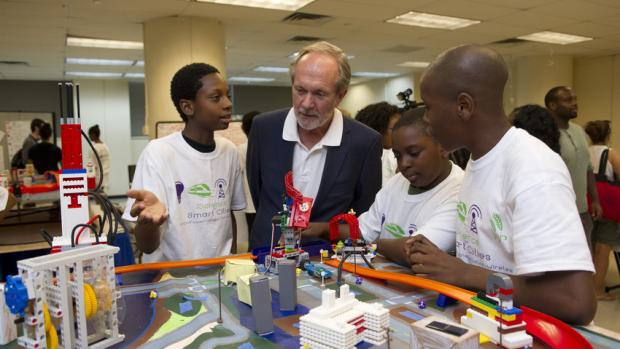Students Discover the Science Behind Smart Cities

Was Ben Esner, director of the Center for K-12 STEM Education at the Polytechnic Institute of New York University (NYU-Poly), saving the best for last? The center focuses on providing science, technology, engineering and mathematics — the so-called “STEM” disciplines — to K-12 students and teachers. In the final week of its month-long Science of Smart Cities (SoSC) program, the center’s thirty-six middle-school participants were treated to a field trip at the downtown Brooklyn offices of Northrop Grumman, a leading global security company.
Ranked among the top 200 corporations in America by Fortune magazine in 2011, the company is an avid supporter of STEM education. At the U.S. News STEM Solutions Summit in June, Northrop Grumman Chairman, Chief Executive Officer and President Wes Bush said, “We’re focusing on partnerships that are active and cover the full spectrum of education.”
Four weeks later, the company opened its doors to the SoSC students, who would spend their time at the firm receiving instruction from Northrop Grumman engineers. The lessons fit into the overall curriculum of the inaugural SoSC program, which introduced students to a range of contemporary urban topics, such as traffic engineering and sustainability. Each week addressed a different theme: energy, transportation, communication, and food and sustenance. Students were then encouraged to draw from what they learned and build a “smart city” of their own, with their efforts chronicled in the program’s daily blog, to which they would contribute between visits to farms and firms like Northrop Grumman.
Learning from the Experts
“From Poly’s perspective, this day is a model,” Esner said. “We don’t want to just call faculty to give a talk. We want companies to be engaged in teaching what they know.”

The presentations were followed by interactive workshops also led by Northrop Grumman employees. At one, Northrop Grumman New York Solutions Center manager Stephen Cahnmann talked about modems that could solve traffic issues, as well as streamline cities’ disaster response systems. The high level of engagement from his audience gave him hope for the field’s future workforce. “It’s crucial to keep a fresh pipeline of the ones who will have the next big idea,” he said.
His colleague, applications systems engineer McKinley Stacker, who also led a workshop, agreed. “It’s good to inspire young minds,” he said, noting that the workshops benefited him, too. “It helps me reiterate my own understanding. I talk to technical people all day, and this was a chance to explain my work in nontechnical terms.”
Inspiration to Hands-On Practice
The day wasn’t over yet, though. It would conclude with a Think Tank Activity, which asked students to take what they had learned that day, divide into groups and work collaboratively to develop an application that would make their city function better or “smarter.” Partnered with an 
“You should be able to see on your phone where buses and trains are!” exclaimed one student, with a classmate agreeing, “Yeah, information is vital.” Still another shot out one more idea — “How about a taxi-monitoring system?” — with the students’ enthusiasm causing their voices and innovations to override each other in an audible demonstration of the day’s success.
Eventually a winner was decided: The group that proposed bringing WiFi to subway platforms by taking advantage of communications systems already in place. Each team member walked away with a notebook, but all of the students were given prizes.
Students Become the Teachers
Existing students at NYU-Poly and alumni were similarly rewarded, with Monique Delmar, a systems engineer at Northrop Grumman and NYU-Poly graduate, coordinating with Esner to bring the SoSC program to her company’s office. Her intern, Jason Duffy, currently a mechanical engineering student at Delmar’s alma mater, also joined in as a leader of one of the workshops, while instructors of the SoSC program—all students at NYU-Poly—guided the middle-schoolers on a weekly basis. Program director Dominick Dennisur, a mechanical engineering student at NYU-Poly, said, “The group definitely experienced our fair share of challenges, but staying in the classrooms late into the night preparing activities for the week was all worth it when seeing the joy on the students’ faces when they did those activities.”
For instructor Howard Jiang, a rising senior in civil engineering, the program was “a game changer when it comes to personal growth. It allowed me to develop a new level of confidence and ability to communicate engineering and scientific principles,” he said.
The most meaningful part of the experience for Jiang, though, was sharing his love of engineering  with students. “As a camp instructor and a NYU Poly student, I wanted my students to be role models in society when it comes to sustainability and environmental responsibility,” he said. “Students arrived on the first day knowing that global warming is bad. Thanks to this camp, students left knowing how our actions mitigate or amplify climate change and how using technologies such as a biodigester can potentially slow down climate change.”
with students. “As a camp instructor and a NYU Poly student, I wanted my students to be role models in society when it comes to sustainability and environmental responsibility,” he said. “Students arrived on the first day knowing that global warming is bad. Thanks to this camp, students left knowing how our actions mitigate or amplify climate change and how using technologies such as a biodigester can potentially slow down climate change.”
Jiang may be pleased to know that his charges walked away with more than just faith in their ability to reverse the damages of climate change. They also began to imagine possible futures as engineers. “We made a wireless car. Makes me want to be an engineer,” said Stiven, 12.
“It feels like I already am an engineer,” his classmate Ezron, 13, chimed in.





